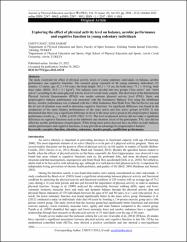| dc.contributor.author | Canlı, Umut | |
| dc.contributor.author | Samar, E. | |
| dc.date.accessioned | 2023-05-06T17:22:09Z | |
| dc.date.available | 2023-05-06T17:22:09Z | |
| dc.date.issued | 2022 | |
| dc.identifier.issn | 2247-8051 | |
| dc.identifier.uri | https://doi.org/10.7752/jpes.2022.10318 | |
| dc.identifier.uri | https://hdl.handle.net/20.500.11776/12080 | |
| dc.description.abstract | The study examined the effect of physical activity levels of young sedentary individuals on balance, aerobic performance and cognitive functions. The research group consisted of 44 young sedentary individuals (32 females; 12 males; age: 42.2 ± 9.6 years; the body height: 162.3 ± 7.8 cm, the body mass: 71.3 ± 14.6 kg, body mass index (BMI): 26.9 ± 5.1 kg/m2). The subjects were divided into two groups (“less active” and “more active”) according to the mean physical activity level of overall study sample. The short form of the International Physical Activity Questionnaire (IPAQ) was usedto estimate physical activity level (PAL). Static and proprioceptive balance performance was measured with the Sensamove Balance Test using the Miniboard device. Aerobic performance was evaluated with the 1-Mile Endurance Run/Walk Test. The Go/No-Go test and the d2 test of attention were used to determine cognitive functions. No significant difference was found in the comparison of the static balance performances of the more active and less active groups (p>0.05). It was determined that there was a significant difference in favor of the more active group in the proprioceptive balance performance results (?(1)2: 4.494; p>0.05; (Phi)3: 0.32). The level of physical activity did not make a significant difference on cognitive functions such as the inhibition and attention levels of the participants. PAL also did not affect the aerobic performance of participants. While being more active does not have an effect on static balance, aerobic performance and cognitive functions, it may provide an advantage for proprioceptive balance. © 2022, Editura Universitatii din Pitesti. All rights reserved. | en_US |
| dc.language.iso | eng | en_US |
| dc.publisher | Editura Universitatii din Pitesti | en_US |
| dc.identifier.doi | 10.7752/jpes.2022.10318 | |
| dc.rights | info:eu-repo/semantics/openAccess | en_US |
| dc.subject | attention | en_US |
| dc.subject | endurance | en_US |
| dc.subject | equilibrium performance | en_US |
| dc.subject | executive function | en_US |
| dc.subject | inactive people | en_US |
| dc.title | Exploring the effect of physical activity level on balance, aerobic performance and cognitive function in young sedentary individuals | en_US |
| dc.type | article | en_US |
| dc.relation.ispartof | Journal of Physical Education and Sport | en_US |
| dc.department | Fakülteler, Spor Bilimleri Fakültesi, Beden Eğitimi ve Spor Eğitimi Bölümü | en_US |
| dc.identifier.volume | 22 | en_US |
| dc.identifier.issue | 10 | en_US |
| dc.identifier.startpage | 2504 | en_US |
| dc.identifier.endpage | 2512 | en_US |
| dc.institutionauthor | Canlı, Umut | |
| dc.relation.publicationcategory | Makale - Uluslararası Hakemli Dergi - Kurum Öğretim Elemanı | en_US |
| dc.authorscopusid | 57206271667 | |
| dc.authorscopusid | 57219268858 | |
| dc.identifier.scopus | 2-s2.0-85140926538 | en_US |



















